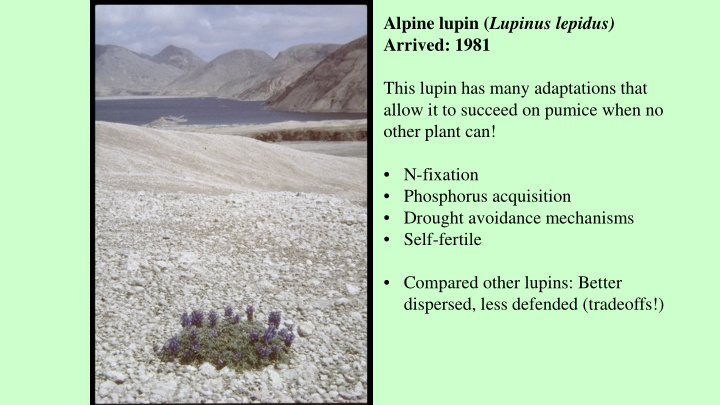



Alpine lupin ( Lupinus lepidus) Arrived: 1981 This lupin has many adaptations that allow it to succeed on pumice when no other plant can! • N-fixation • Phosphorus acquisition • Drought avoidance mechanisms • Self-fertile • Compared other lupins: Better dispersed, less defended (tradeoffs!)
2002 Lupins spread!
• Community N-limited • Lupin is P-limited Ecosystem N is limited by P Is system nutrient limited? Experiment: add nitrogen or phosphorus (repeated 2002-2006)
13 years later + 400 kg N/ha + 50 kg P/ha 7 years after stopping experiment – no visible effect. Undeveloped soils cannot retain nutrients!
Other plants could only grow in dead lupins!
Sedum oreganum
Spiranthes romanzoffiana
Western white pine
Lupins create soil that other species require to colonize
Lupinus lepidus population dynamics % Cover by Lupin Data from Roger del Moral, University of Washington
Specialist Root Boring Caterpillars Hystricophora Grapholita Hystricophora nr. roessleri (Tortricidae) Grapholita lana (Tortricidae)
LEAF MINER REMOVAL Density explosion Removal: 3.3x increase yr -1 Control: 0.36x decrease yr -1 August 3, 2004 Fagan and Bishop 2000. American Naturalist 153: 238-251 Bishop 2002. Ecology. 83: 191-202 Bishop et al. 2005. in Ecological Responses to the 1980 Eruptions of Mount St. Helens Fagan et al. 2005. American Naturalist. 166: 669-685
Our data show: • Each crash caused by insects • Crashes slowed spread across landscape • Still occurring after 25 years! (but in smaller areas)
Conclusion:
Conclusion:
Sitka Willow (Salix sitchensis) July 2010 Upland areas: Willows establish but don ’ t grow large
Cryptorhyncus lapathi (Curculionidae) Paranthrene robiniae (Sesiidae).
After 10 years of borer exclusion (2017) Not Sprayed Sprayed
Control plot, 2014 71 willows in 2008, 4 in 2016
Same plots in Google Earth Willow borer exclusion (2018, year 11) Control plot in foreground, Protected plot in background
1080m elev. 1290m elev.
Year 11 Litter Layer in 400 cm 2 @ 0.5m from base Typical control Typical sprayed plant
Do early successional interaction webs promote extreme dynamics? Insectivorous birds Small mammals Parasitoids Ants, Spiders Beetles Seed predators Leaf tiers Plant Root borers competitors Soil Resources
Do early successional interaction webs promote extreme dynamics? Seed predators Leaf tiers Plant Root borers competitors Soil Resources
Hypothesis : Low community complexity in early succession promotes extreme interactions If true • Extreme herbivore effects involving multiple hosts • Effects should diminish with system maturity • Less effect in secondary succession • Should occur in other primary successions Seed predators Leaf tiers Root borers Soil Resources
Leaf Miner Damage Surveys: ~160 sites/year for 17 years • High chronic damage • High heterogeneity • Diminished by community development
Weevil Damage Survey: 154 plots on 9km transects ~620 plants/year ~64% of all stem area is attacked ~90% stem mortality ~50% stem mortality
High density patch Low density patch
Larval mortality 50 50 45 45 40 40 Number of larvae alive 35 35 30 30 25 25 20 20 15 15 10 10 Core 5 5 Edge 0 0 0 10 20 30 40 50 60 70 80 90 100 110 Day Tarone-Ware log-rank test: χ 2 = 4.888, p = 0.027
Paradox of Enrichment: High Density compete for P! Have less P/g leaf Larvae are P limited
Summary of 1980 2007 2010 2013 2016 2018 151 un- Exclu redisturbed sions sites Cover 0% 40% 45% 48% 67% >100% # of Species 0 78 107 137 155 Moss % 0% 13% 26% 27% 26% 40% Lupin % 0% 24% 11% 4% 18% 20% Willow % 0% 6% 4% 4% 5% 50%
What Controls Establishment of a New Conifer Forest? Conifer colonization at 170 transect points • Three factors controlling conifers (Titus & Bishop 2014, Birchfield & Bishop Western Hemlock unpub., Wenke & Bishop unpublished) Seed limitation: adding Doug fir seeds led to high density of doug fir. Competition: Doug fir couldn’t establish in thick lupins or under shrubs Noble Fir Environmental conditions: 1) Fir trees more likely on steep north facing slopes (higher moisture availability) 2) Hemlock seeds have always blown in, but only started establishing in year 30! Typically in locations where soil is developing.
Monument Act (1983): allow “ the natural recovery of the volcanic landscape, to the benefit of public and scientific understanding ” “protect the geologic, ecologic, and cultural resources.”
Recommend
More recommend